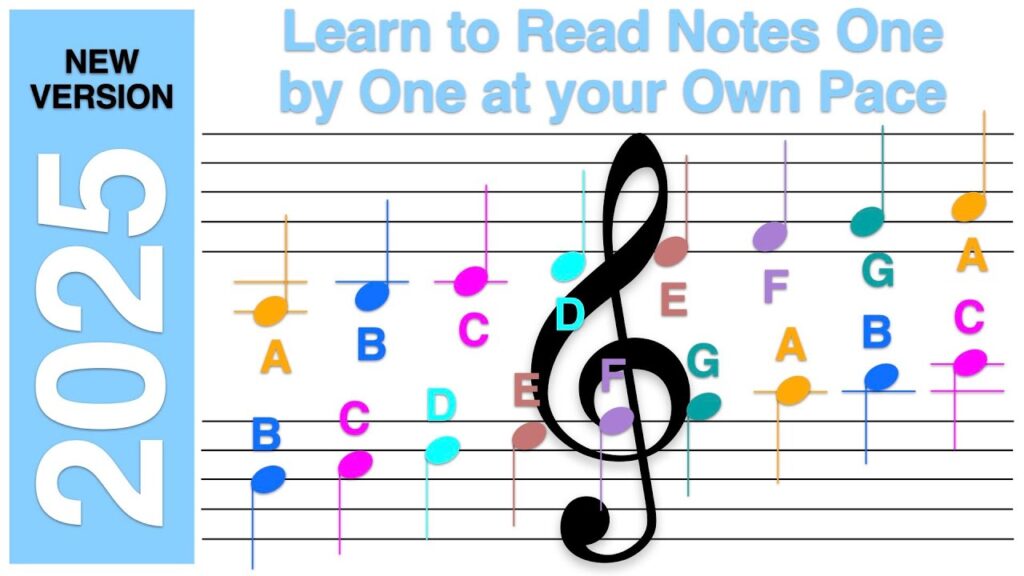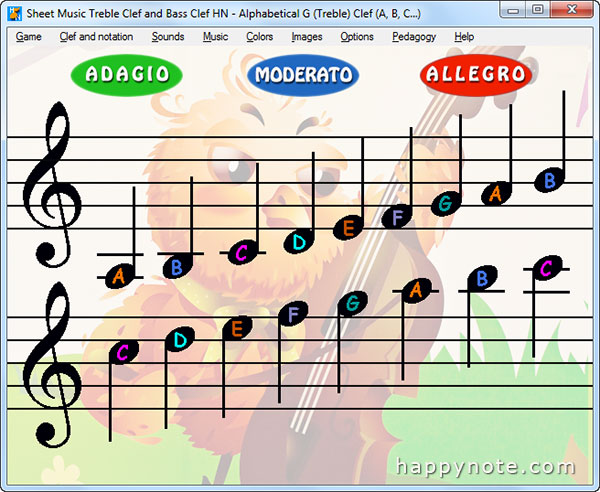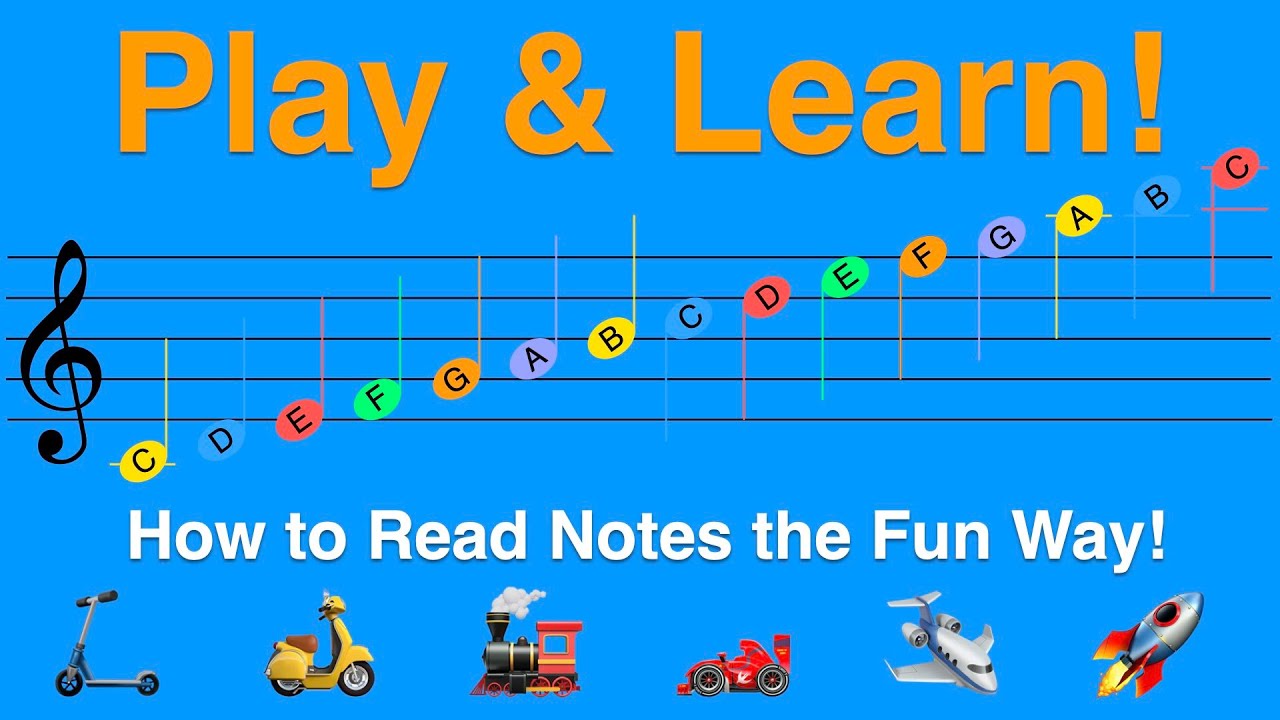Learning to read music has never been easier or more fun. Created in 1999, Happy Note! offers videos and even games to help you quickly and easily learn to read notes in the treble clef and bass clef, with the help of sound and colored notes.
Do Beginners Need to Know Music Theory to Read Notes?
NO, Not at all!
Our videos and games are designed so you can start learning to read music notes immediately, no theory required.
However, if you’re curious about the building blocks of sheet music, these core concepts will help you understand how it all works:
- The Music Staff: The 5 lines and 4 spaces where notes are written.
- Music Clefs: The symbols (like Treble or Bass clef) that tell you which note is on each line.
- Music Notes Names: The different systems for naming the notes, such as A, B, C or Do, Re, Mi.
Already got some note-reading skills? Put them to the test with a salsa beat!
Find the Right Video in 1 Minute!
Before you start learning to read your first notes with the help of sound and color, you need to choose:
- your notation (A B C or Do re Mi)
- your clef (treble of bass)
- your speed (slow, walking pace, moderate speed)
A B C or Do Re Mi? Music Notation Depends on Your Country
First, choose the note naming system that works best for you:
A B/H C D E F G
or
Do Re Mi Fa Sol La Si/Ti.
- Choose the alphabetical A B C D E F G system if you live in an English-speaking country or plan to play jazz.
- Choose the A H C D E F G system where H replaces B if you live in Germany, Poland, or a Scandinavian country.
- Choose Do Re Mi Fa Sol La Si if you live in a country that uses fixed-do solfège (Do = C) or if you want to learn the Norwich sol-fa system invented by Sarah Anna Glover, where “Si” was changed to “Ti” to give each syllable a unique initial letter.
Not sure which musical notation is used where you live?
Learn more about note names in different countries.
Treble or Bass Clef? The Right One Depends on Your Instrument or Vocal Range
The Treble Clef is used with the sheet music for:
- Violin
- Cello
- Guitar
- Mandolin
- Harp
- Harpsichord
- Piano
- Clarinet
- Oboe
- English horn
- Organ
- Accordion
- Saxophone
- Trumpet
- Flute
- French horn
And for vocalists, with the voice parts of:
- Tenor
- Soprano
- Contralto
- Alto
- Mezzo-soprano
The Bass Clef is used with the sheet music for:
- Piano
- Harpsichord
- Organ
- Harp
- Cello
- Double bass
- Trombone
- Bassoon
- Contrabassoon
- Tuba
- Guitar
- Bass guitar
And for vocalists, with the voice parts of:
- Bass
- Baritone
Some music instruments, like the piano, require reading both clefs: treble clef for the right hand and bass clef for the left.
Note: The viola uses the C clef placed on the 3rd line. – Learn more about music clefs.
Video Speed (Adagio, Andante, Moderato)
Most videos designed to help you learn to read music are available at three speeds: Adagio, Andante, and Moderato. Choose the speed that fits your skill level, whether you’re a beginner or want to improve your reading.
If you’re unsure which speed to pick, we recommend starting with Adagio (slow).

Choose Your Video
Now you know enough to choose the right video.
As a reminder, Adagio = slow, Andante = walking pace, Moderato = moderate speed.
Treble Clef (G Clef)
- Treble Clef, A H C, Adagio (German notation)
- Treble Clef, A H C, Andante (German notation)
Bass Clef (F Clef)
Piano and Keyboards (Harpsichord, Organ, Synthesizer…)
If your instrument is a piano or another type of keyboard, you need to learn to read the treble clef – for the right hand – and the bass clef – for the left hand.
Happy Note! offers videos specifically dedicated to helping you learn how to read piano sheet music. Each new note you learn to read is shown on the corresponding key of an 88-key keyboard.
Reading Notes on Piano Sheet Music
Follow the link above to choose between right and left hand, and between A B C and Do Re Mi notation.
The Benefits of Learning to Read Notes with Happy Note! Videos
In addition to using colored notes to make it easier to identify new ones, learning with Happy Note! videos comes with many advantages:
Unconscious Ear Training
Listening to the notes while reading or singing them helps train your ear to naturally associate each pitch with its name, improving aural recognition.
Tempo Control
Each video keeps a steady tempo, helping musicians learn how to “keep the beat”—that is, to play without unintentionally speeding up or slowing down. This is essential for mastering an instrument, especially in ensemble playing.
Improved Reading Speed
Thanks to multiple speeds (Adagio, Andante, Moderato), you can progress at your own pace. Two more speeds—Largo (very slow) and Allegro (fast)—are coming soon. Subscribe to the Happy Note! YouTube channel to stay up to date with daily releases.
Learning to Read Music Can Be Fun
If you prefer a more playful approach, choose one of these two options to learn to read music.
A Real Video Game (Treble and Bass Clef)

If you’re on a Windows computer, try the Sheet Music Treble Clef and Bass Clef HN game. It lets you choose between the Do Re Mi and A B C notation systems, and even the German one using H instead of B.
A Fun Video (Treble Clef)

From 2 to 15 notes—can you read the music notes faster than the video?
Do Re… Si/Ti videos are also available — just click the image above.
To Read Music, you Also Need to…
Knowing the names of notes is the most important for reading sheet music; however, you also need to know the note values and durations (whole note, half note, quarter note, eighth note) and the rests and their durations (whole rest, half rest, quarter rest, eighth rest); not to mention the rhythm (meter, tempo, metronome) and accidentals: sharp, flat, natural.